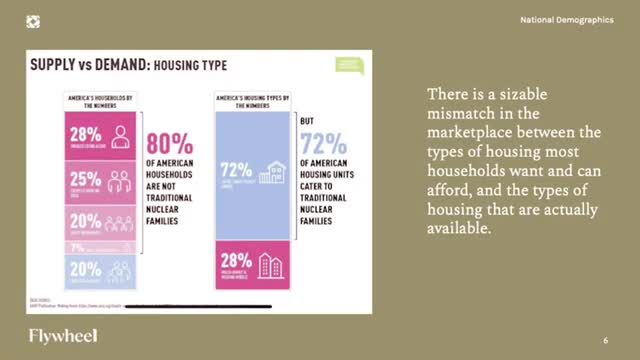Housing crisis deepens as demographics clash with market trends
September 30, 2024 | East Lansing, Ingham County, Michigan
This article was created by AI summarizing key points discussed. AI makes mistakes, so for full details and context, please refer to the video of the full meeting. Please report any errors so we can fix them. Report an error »

In a recent government meeting, officials discussed the pressing issue of housing stock and its alignment with current demographic trends. National data revealed that 72% of the housing market consists of single-family homes, while only 28% includes townhomes, duplexes, or multifamily units. This distribution raises concerns about whether the existing housing options adequately meet the needs of diverse household types.
According to the data presented, 28% of households are singles living alone, 25% are childless couples, and 20% consist of roommates, with traditional nuclear families making up only 20% of the total. This mismatch between housing types and household compositions suggests a significant disconnect in the market, prompting officials to acknowledge that regulatory codes have not kept pace with demographic shifts.
In East Lansing, the Census Bureau reports approximately 16,500 housing units serving a population of 47,390, resulting in an average of 2.86 people per household—higher than the national average. This figure is likely influenced by the prevalence of roommate situations, particularly among students. A striking example highlighted was a six-bedroom rental property listed at $6,610 per month, raising questions about affordability and competition for families with children.
Officials emphasized the need for a reevaluation of housing policies to better accommodate the changing landscape of household types, urging a proactive approach to align housing availability with the community's demographic realities.
According to the data presented, 28% of households are singles living alone, 25% are childless couples, and 20% consist of roommates, with traditional nuclear families making up only 20% of the total. This mismatch between housing types and household compositions suggests a significant disconnect in the market, prompting officials to acknowledge that regulatory codes have not kept pace with demographic shifts.
In East Lansing, the Census Bureau reports approximately 16,500 housing units serving a population of 47,390, resulting in an average of 2.86 people per household—higher than the national average. This figure is likely influenced by the prevalence of roommate situations, particularly among students. A striking example highlighted was a six-bedroom rental property listed at $6,610 per month, raising questions about affordability and competition for families with children.
Officials emphasized the need for a reevaluation of housing policies to better accommodate the changing landscape of household types, urging a proactive approach to align housing availability with the community's demographic realities.
View full meeting
This article is based on a recent meeting—watch the full video and explore the complete transcript for deeper insights into the discussion.
View full meeting
